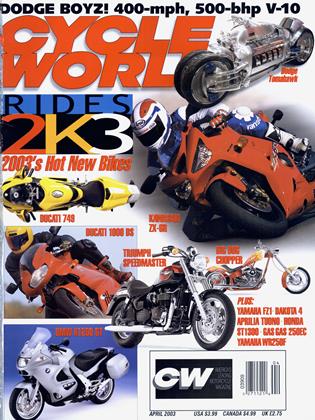Don Vesco, 1939-2002
The Forever Racer
The first time Don Vesco broke the 200-mph mark at the Bonneville Salt Flats, he did so at 222 mph. At 2:22 p.m. last December 16, Don Vesco passed away, his short bout with prostate cancer ending in one of the few battles he ever lost. It would be easy to say that Vesco died without realizing his ultimate dream. After all, he craved the notion of going 500 mph. Why? Because it was the next step for a man who lived by centurion milestones. But once he reached 500 mph, he would have wanted to go 600 mph. Thus, the man didn't die without realizing the dream, he just kept reinventing those dreams until he finally ran out of time. As it turns out, the only thing that could slow him was death. But, boy, did he ever live.
For Vesco, the initial goal was to go 200 mph. Nowadays, a bit of work on a Suzuki Hayabusa and a decent day at Bonneville will get you enshrined into the 200-mph club. But not then, not 1970 when Vesco first went more than 200 mph on a motorcycle. Back then, it required more because you were working with less. For his run at the record book, Vesco need ed a streamliner, so one was built at his shop in El Cajon, California-Don Vesco Yamaha. At first, Yamaha engines pow ered the long, skinny contraption, then Kawasakis. And the speed continued to increase, the goal always changing. Two hundred mph quickly turned into 300, and for 19 years Vesco held the motorcycle land-speed record with his run of 318.598 mph. But that wasn't enough. See, 400 mph loomed on the horizon, and it would take more than a motorcycle to do that. So Vesco turned his attention to four wheels, and the turbine powered Turbinator.
In 2001, Vesco went 458.44 mph, peering through just one eye, the sight in his left eye gone-result of an innocent little accident while spectating at a sprint-car race. A rock had flown from the wheel of a race car, striking Vesco. A man who risked life and limb in the pursuit of speeds most don't even know exist losing his sight while watching a car race? Strange, but true. Still, it didn't slow him down.
Next was 500 mph, and many feel he would have accom plished that in 2002-only two months prior to his death-if not for a hiccup at the 11th hour. In order to go 500, Vesco and crew-headed by his brother, Rick-figured they had to get more air into the Turbinator's engine. To accomplish this, the body had to gain some length. Three months of working with noted fabricator Rob North got that accomplished. The Turbinator was stretched, ready for an October attempt. But it all came apart just prior to departure for Utah. The crew had lit the tur bine a few times that day without problem. Then the front end of the vehicle was on a fork-lift, readying to be loaded. At that point, with the rear wheels rolling, the crew heard a scraping noise. Stress had bent the impeller, which was now hitting the housing, and there is no easy fix with a turbine. End of dream.
"He was there. He would have done it this time," says long time Vesco friend and confidant, Gordon Menzies.
Though no one other than Vesco knew it, time was finally running out on a man who had constantly battled the clock.
"It was very important to him," Menzies said of Vesco's fight to reach 500 mph. "It wasn't so much the record. It's hard, maybe impossible, to explain. He knew that records were meant to be broken, even his own.
He just tried to set them high so it was harder to knock them down. He just always set a goal. That (500 mph) was the next goal, but then there would have been another one.”
Unfortunately, Vesco didn’t attack cancer as seriously as he attacked the record book. He was sick, but he didn’t let anyone know. He had the goal, you know. And even late in his illness, he still figured he’d make it back to the Salt Flats in September for one last shot.
“I think Don just treated it like it was a cold, like it was going to go away,” Menzies said. “I think he found out so late, too late. I think at that point, all he did was suck it up.
That last run was very important to him. He was going to let it hang out, though he always let it hang out. I think he knew he was on borrowed time. I think he was really looking forward to September, 2003. He
didn’t think he was going to die. It wasn’t in his plan.”
Vesco was more than just a man who chased speed. He was a man who provided others with the opportunity to pursue their dreams as well, especially if those dreams revolved around racing motorcycles. Vesco, through his little shop in El Cajon, sponsored many a racer-from the unknown local motocrosser or desert racer to the likes of roadracers such as 250cc World Champion Kel Carruthers and AMA Grand National Champion Gene Romero, the latter on a TZ750 Yamaha. Those men, and hundreds like them, paid their final respect to Vesco on a rare rainy day in El Cajon, five days after his death.
As Wes Cooley Sr. said during one of several eulogies for Vesco, the ultimate compliment for any man is to have the respect of his peers. Vesco had that respect. Ten times over.
Godspeed, Don.
-Paul Carruthers













